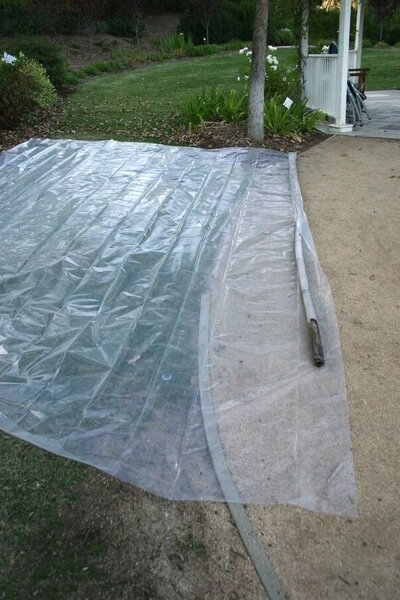Soil solarization: A chemical-free way to get rid of weeds and unwanted grass
Loading...
We use the sun’s rays to power our houses, heat water, and even run cars. How about using the sun to kill our lawns, too?
The process, which is called solarization, uses the heat of the sun’s rays to literally cook plants, weed seeds, nematodes, insects, and soil pathogens (the “bad guy” fungi, bacteria, etc. that bring diseases to plants) in the uppermost layers of soil.It also makes nutrients more available to plants later grown in solarized soil.
This is an excellent way of getting rid of grass where you would like to plant something else.
Summer is the best time of year to solarize. The air is warm, but more importantly, this is when the sun has its greatest heating potential. After six weeks or so, your lawn will be gone with a minimum investment of time, energy, money, and, best of all – no herbicides!
Solarization comes to us from the clever folks in Israel where resources are limited but demand is great.
How to solarize soil
- Cut your lawn very, very short. Make the surface as smooth and even as possible.
- Irrigate to saturate the soil one to two feet deep.
- Cover the lawn with 2 to 4 mil clear plastic (see note below) sheeting (available in the paint section of the hardware store. This is the most environmentally "unfriendly" part). Spread the plastic so it is in contact with the soil surface, and leave as little air space as possible
- Extend the plastic six to eight inches beyond the edges of the grass. The edges don’t heat as well as the center so extending the plastic ensures even heating throughout.
- If the area is large enough to need several sheets of plastic, overlap the seams.
- Anchor around the edges of the plastic with rocks, bricks, wood planks, mounds of soil, etc.
- Turn automatic irrigation off. (Imagine what would happen if the water went on with plastic covering sprinkler heads!)
- Wait six to eight weeks.
- Remove the plastic carefully. If the plastic doesn’t have UV inhibitor (nice but not necessary), it will likely fall apart by the time the lawn is dead.
To make the process even more effective, spread a second layer of plastic over the first. Use planks of wood or bricks to create a few inches of air gap between them. Research shows that the second plastic layer raises soil temperature another 2 to 10 degrees.
After solarization
Since the plastic is clear, you can watch the lawn turn from green to yellow, then to straw brown. Once that happens, let the plastic sit another week or two, just to be sure.
When the lawn is dead, you have a few options. Clear away dead grass where you plan to put walkways or otherwise need an even surface. Where the lawn is to become planting bed, just treat the dead stuff as compost. Plant into or mound soil atop it. Eventually, it will disintegrate either way.
Since solarization works best in the upper foot or so of soil, don’t rototill the soil after you are done. (Actually, it's best not to rototill ever. Rototilling, or turning the soil deeply, brings seeds and pathogens to the surface where they will proliferate.)
Questions answered
Why irrigate first? Wet soil heats more quickly than dry soil.
Why clear plastic is a must: I’m often asked if black plastic works as well as clear. The answer is a definite “NO!” It’s a matter of physics, but rather than give you a complex explanation, here’s an example from our everyday experiences that demonstrates the concept.
Imagine you park your car in a sunny parking lot, in the middle of the day. Roll the windows up, close the doors, and leave it for several hours. When you return, open the door. What’s your first thought? “Boy its hot in there!” We all know that the air inside a closed up car heats up more than the outside air.
Now, have your car windows tinted. Repeat the process and compare the air inside the car to the air outside. What happens? Even though the surface of the car heats up the same both times, the inside of the car gets far hotter when its windows are clear (similar to clear plastic) than when they are tinted (similar to black plastic).
This is the “greenhouse effect.” Clear glass and clear plastic trap the heating power of the sun’s rays. That's why soil beneath clear plastic heats up more than soil beneath black plastic. Adding an air gap and a second layer of plastic heats the soil even more.
Can I solarize other areas of my yard, too? Certainly! Raised beds, perennial beds, weed-infested fields, even slopes can be solarized to kill weeds, pests, and pathogens. As long as you can make the surface flat enough for the plastic to lie tight against the soil, you can solarize. But remember that solarization will kill all plants beneath the plastic. First remove any plants that you don't want to die.
-----
Nan Sterman is a popular writer and speaker about gardening and is a garden coach and garden designer. She also hosts the TV show "A Growing Passion" in San Diego and is the author of "Water-Wise Plants for the Southwest" and "California Gardener's Guide, Vol. II." Her website is Plant Soup. Read more of what she has written at the Monitor by clicking here.






